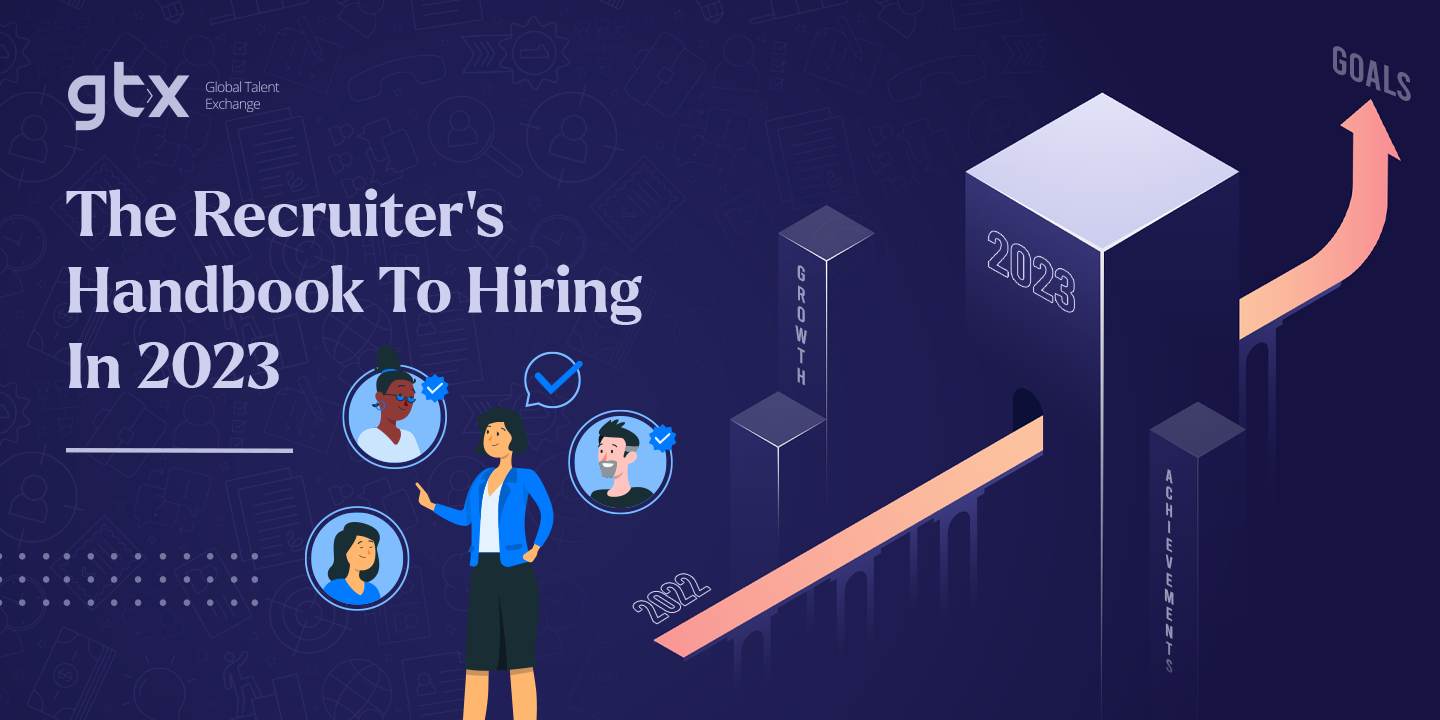As the world becomes increasingly interconnected and borderless, global recruiting and the search for global talent is becoming all the more important for companies. However, the search for such skilled talent is no easy task- the pool of potential candidates is larger indeed, but that means it would require additional time and effort to sift through them.
A global approach to talent acquisition is a powerful tool in the hands of those who yield it well- it enables companies to access a wider range of skills and perspectives, which can lead to increased innovation and competitiveness.
However, despite the many benefits, organizations hold back and are hesitant to pursue this strategy due to a number of myths. Such misconceptions can prove harmful; not only do they hold leadership back from finding and retaining the best talent, but also hamper growth and progress in the long run.
In this blog, we shall debunk a few myths from our own experience in this industry and delve into the current trends in global hiring to help you make informed decisions about your organization’s talent strategy. All this for just one reason- so you can position your business for success in today’s global marketplace with a diverse and open-minded workforce. Read on.
Busting Myths Around Global Recruiting
#1 Global recruitment is only for large, multinational companies
A common perception that organizations cling to is that global recruitment is only feasible and “possible” for large companies with extensive amounts of resources. However, the truth is that small and medium-sized enterprises can actually stand to gain a lot from recruiting around the world.
Look at it this way- a small company is in the process of solving business problems and trying to crack the code to scale quickly and smoothly. If anything, this makes it even more important that they utilize the immense knowledge, skill, and experience of a global recruit to tap into different markets and succeed soon.
Furthermore, a global recruitment strategy can be cost-effective for small and medium-sized enterprises, as it allows them to tap into talent markets where costs may be lower. Restricting hiring efforts to a specific geographic area, such as your city or state, can be highly limiting and can make it difficult for an organization to ever find what they set out looking for, which will lead to higher turnover rates and wasted resources on training, development, and HR. It’s better to hit the nail on the head the first time.
An associated consideration (which is yet another myth) is that global talent wouldn’t be interested in working for an organization that isn’t popularly known. Times are changing, and skilled professionals are now attracted to companies that can offer them a good work-life balance, career development opportunities, a positive culture, and a strong sense of purpose- regardless of the size of the company.
#2 A Globally Dispersed Team Is Challenging To Manage
A common myth that many leaders and organizations believe is that it is difficult to manage a globally dispersed team. While it is true that managing a team that is spread across different locations and time zones can present some challenges, it isn’t all that different than managing a co-located one. With the right strategy, certain obstacles can be easily overcome and you’ll find that the benefits far outweigh them.
One barrier that could present itself when managing a globally dispersed team is communication barriers. Language and cultural differences can make it difficult to communicate effectively when your talent is located in various parts of the world. However, this can be easily overcome with the use of tools such as video conferencing and translation software. The time zones can be tricky to navigate around too, but there’s a solution for everything. Utilize time management tools and techniques, such as scheduling meetings at times when everyone would be available and ensuring that everyone in your team is well aware of the suitable times to reach out to the others.
Some organizations also feel it’s harder to observe and assess a remote employee’s work. This can be overcome with the use of project management software and firm policies and guidelines that set clear expectations.
#3 International Recruitment Is Resource-Exhaustive
Many perceive global recruitment to be slow, resource-exhaustive, and expensive. In fact, there are several ways that companies can streamline the process to make it extremely efficient and cost-effective.
One way to do this is by utilizing the gift of technology! Video conferencing tools, digital platforms, and virtual job fairs are excellent ways to connect with a global pool of candidates from your desk and conduct interviews remotely as well- eliminating the need for travel and other logistical expenses.
Working with trustworthy recruitment platforms and consultants is another way to drastically speed up the process, due to their experience in sourcing and vetting candidates from skill-rich hubs around the world, saving you the time and effort of hunting for talent.
Most significantly, it’s crucial to remember that the long-term value that a global recruit can bring to the company is immense. In some instances, the upfront costs of hiring and onboarding a skilled professional from another region may be higher, but the ROI shall exceed that as the employee is sure to be a valuable addition to the team.
In fact, a study by McKinsey displayed that diverse workforces yield better financial results! It revealed that companies ranking in the top quartile for diversity within their executive boards achieved a 53% higher Return-On-Equity (ROE) on average. Just another reason to consider hiring globally to fill leadership positions within your company!
#4 Global Recruits Cause Friction & Conflict Within Teams
Many organizations believe that global employees create friction within the team due to several differences in culture, language, method of working, etc. However, this is entirely baseless!
On the contrary, an international recruit can contribute richly to the team by bringing to the table a wide range of perspectives and ideas which, in turn, leads to more innovative solutions and better decision-making.
Moreover, when people from various backgrounds and walks of life get together, it results in a rich exchange of experiences and insights which fosters a positive work environment that prioritizes diversity and inclusion.
Like any other team member, a global employee may need some time to adjust to their new surroundings and colleagues. However, with the right support and resources, this process can be sped up effectively.
#5 Global Recruitment Is Unfair To Local Talent
Another common myth is that global recruitment is unfair to local talent and steals jobs from them. However, this is a highly pessimistic approach to take.
In reality, cross-border hiring is necessary and crucial for companies to fill talent shortages within their teams and bring diverse perspectives to the organization. This is especially true of niche skill areas such as emerging technology roles in Artificial intelligence, machine learning, robotics, and more. The harsh truth is that such knowledge and expertise is often not available locally and would require extensive training and development before it matches up to the standards of a competitor or the global markets. Organizations do not have that kind of time to lose out on if they want to maintain their advantage and remain a few steps ahead in the game.
Moreover, as mentioned in the point above, global recruitment drastically broadens the horizon of the local team as well as they are exposed to a range of new ideas and experiences that can help majorly in career development.
This has been substantiated by and displayed in a report by Deloitte as well- if employees believe their organization is committed to, and supportive of diversity, it improves their ability to be innovative and can yield higher financial returns. Further, the study also reported that feeling included within such a well-rounded workforce leads to improved team collaboration and performance.
Global talent trends
There are several major trends shaping the global talent landscape today. One trend is the increasing use of technology to streamline and automate the recruitment process. Companies are leveraging online job fairs, applicant tracking systems, and other tools to reach a wider pool of candidates and more efficiently screen and select the best candidates for their open positions.
The rise of remote work and flexible working arrangements is another trend that has been accelerated by the COVID-19 pandemic. This has led to an increase in virtual hiring and onboarding, as well as a greater need for companies to have strong digital infrastructure and communication systems in place.
Diversity and inclusion are also becoming increasingly important in talent acquisition. Companies are recognizing the value of a diverse workforce and are making an effort toward it through initiatives such as targeted recruitment efforts, employee resource groups, and inclusion training.
There is also a trend towards greater collaboration and partnership between companies, particularly in the tech industry. This can include joint ventures, acquisitions, and talent-sharing arrangements, as companies seek to access new markets and expertise.
In the APAC region, the labor market remains tight, with many countries reporting low unemployment rates. As a result, competition for talent with in-demand skills is expected to remain fierce in 2023. In fact, LinkedIn data predicts that the skill sets required for jobs will have changed by around 25% since 2015, and are expected to reach 40% by 2025.
Companies that hire for skills and invest in upskilling and reskilling their employees will have an advantage in attracting and retaining top talent. It is important for companies to understand the drivers that influence employee priorities, such as compensation, work-life balance, flexibility, and upskilling opportunities, and to listen to their employees in order to develop effective hiring and retention strategies that work to access and bring on board the “cream of the crop” in the industry.
By understanding these trends and obtaining a clear view of the reality of global hiring, companies can position themselves for success in the global marketplace and easily access the top talent they need to achieve their goals.
One company that is well-positioned to help businesses navigate the global talent landscape is Global Talent Exchange (GTX). As a next-gen tech recruitment platform, we enable businesses of all sizes to access highly skilled tech talent from around the world, which helps them scale and compete internationally. With a specialized focus on emerging technology roles and a customer-centric approach to recruitment, GTX has a strong track record of empowering organizations to pursue innovation and bring their vision to life seamlessly.
If global hiring is an element you are looking to incorporate within your recruitment strategy, reach out to us for an effortless process.














